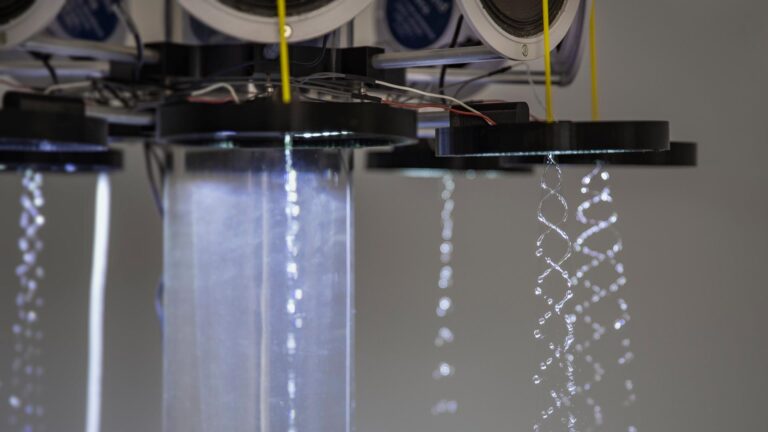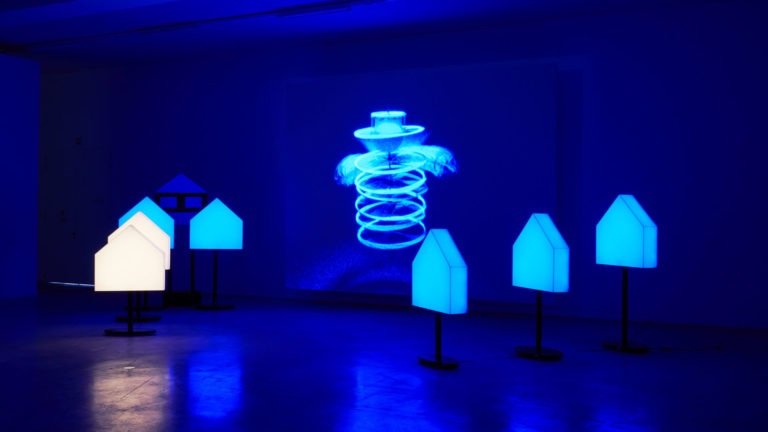Artists: Gustav Metzger, Miroslaw Balka, Marianne Berenhaut, Latifa Echakhch
Exhibition title: ‘Lacrimae Rerum’, homage to Gustav Metzger – Part I
Venue: Dvir Gallery, Brussels, Belgium
Date: September 3 – October 24, 2020
Photography: all images copyright and courtesy of the artists and Dvir Gallery
Dvir Gallery is pleased to present ‘Lacrimae Rerum’ – homage to Gustav Metzger, on view at Rue de Fiennes 85, 1070 Brussels from September 3rd to October 24th, 2020.
The exhibition aims to show a selection of Gustav Metzger’s historical works alongside never seen before pieces by Miroslaw Balka, Marianne Berenhaut and Latifa Echakhch created especially for this exhibition.
Gustav Metzger, born in Nuremberg in 1926, revolutionized the contemporary art world by developing the concept of Auto-Destructive Art and questioning the role of art in the political discourse.
There is no choice but to follow the path of ethics into aesthetics. »
– Gustav Metzger
The opening of ‘Lacrimae Rerum’ – homage to Gustav Metzger will coincide with the Brussels Gallery Weekend.
Gustav Metzger
Born to Polish-Jewish parents in Nurnberg, Metzger was evacuated to Great Britain in 1939 at the age of twelve with the help of the initiative known as the Kindertransport. As a young boy, he became aware of the atrocities of the totalitarian Nazi regime. His parents and other relatives perished in the Holocaust.
In 1959, Metzger wrote his first manifesto, titled ‘Auto-destructive Art’ and with this became the founding father of a radical new form of art. With this and his later manifestos, he showed how society could be destroyed by capitalism, but also highlighted the transformative potential of destruction; for example, the possibility for transformation of society through individual and collective action. In 1961, Metzger demonstrated the concept of ADA for the first time by vigorously spraying nylon canvasses with acid, causing them to disintegrate. This was an attack on, and even a symbolic destruction of, the system. At the same time, Metzger not only rebelled against the political system, but also against the commercial aspects of the art world. In 1977, he proposed a three- year Art Strike, which he hoped would cause a collapse and complete restructuring of the art system.
Gustav Metzger has had solo exhibitions at Serpentine Galleries, London; Tate Britain, London; Museo Jumex, Mexico City; Neuer Berliner Kunstverein, Berlin; Haus der Kunst München, Munich, Kunsthalle Basel, Basel; New Museum, New York; Tel Aviv Museum of Art, Tel Aviv and many others. Moreover, his work was shown at Documenta 13 (2012), the Venice Biennale of 2003 and the Sao Paulo Biennale of 2010.
Latifa Echakhch
Working in painting, sculpture and installations, Latifa Echakhch (El Khnansa, Morocco, 1974) chooses easily recognisable objects invested with a domestic and/or social burden, which she silences through destruction, deletion or by restoring them. This thereby deprives them of their usage value – pushing their function into oblivion – in order to free the memories attached to them. She summons memories and frees the ghosts that emerge from these objects. The work of Latifa Echakhch is simultaneously conceptual and romantic, both political and poetic.
Latifa Echakhch’s work has been presented in numerous solo exhibitions: at the Museum Haus Konstruktiv in Zurich, the Centre Pompidou in Paris, the macLYON, the Hammer Museum in Los Angeles, the BPS22 in Charleroi, the Columbus Museum of Art (Ohio), the Kunsthaus Zurich, the MACBA in Barcelona, the Nouveau Musée National de Monaco, the FRAC Champagne-Ardenne in Reims, the Kunsthalle Fridericianum in Kassel, the Swiss Institute in New York, the Tate Modern in London, the Memmo Foundation in Rome; as well as group exhibitions: at the Museum of Contemporary Art Chicago, the Musée d’Art moderne de la Ville de Paris, the Palais de Tokyo in Paris, the MoMA PS1 in New York, the Fundació Joan Miró in Barcelona, the Contemporary Arts Museum in Houston; and as part of the Istanbul Biennial, the 54th Venice Biennale, the 11th Sharjah Biennial, the Jerusalem Art Focus Biennale and the Manifesta 7 in Bolzano.
Latifa Echakhch won the Marcel Duchamp Prize in 2013 and the Zurich Art Prize in 2015.
She is representing Switzerland at Venice Biennale 2022.
Miroslaw Balka
Miroslaw Balka was born in 1958 in Warsaw, Poland where he lives and works. Comprising installation, sculpture and video, Balka’s work has a bare and elegiac quality that is underlined by the careful, minimalist placement of objects, as well as the gaps and pauses between them. Balka’s work deals with both personal and collective memories, especially as they relate to his Catholic upbringing and the collective experience of Poland’s fractured history. Through this investigation of domestic memories and public catastrophe, he explores how subjective traumas are translated into collective histories and vice versa. His materials are simple, everyday objects and things, but also powerfully resonant of ritual, hidden memories and the history of Nazi occupation in Poland.
Miroslaw Balka has participated in major exhibitions worldwide including: Venice Biennale (1990, 2003, 2005, 2013; representing Poland in 1993), documenta IX, Kassel (1992), Sydney Biennale (1992, 2006), The Carnegie International, Pittsburgh (1995), Sao Paulo Biennale (1998), Liverpool Biennial (1999), Santa Fe Biennale (2006). In 2009 he presented the special project How It Is for the Unilever Series, Turbine Hall, Tate Modern, London. He is the author of the Memorial to the Victims of the Estonia Ferry Disaster in Stockholm (1997), and numerous spatial works including AUSCHWITZWIELICZKA, Cracow (2010), and HEAL, University of California, San Francisco (2009).
Retrospectives of his work took place in such institutions as Pirelli Hangar Bicocca in Milan, Museum of Art in Lodz and in the Museum Morsbroich in Leverkusen. Balka’s works are in numerous institutional collections including: Tate Modern, London; Van Abbemuseum, Eindhoven; MOCA, Los Angeles; SFMOMA, San Francisco; MOMA, New York; Hirshhorn Museum, Washington DC; The Art Institute of Chicago; The Carnegie Museum of Art, Pittsburgh; Museu Serralves, Porto; Moderna Museet, Stockholm; Kiasma, Helsinki; Kröller-Müller, Otterlo; EMST The National Museum of Art, Athens; The National Museum of Art, Osaka; The Israel Museum, Jerusalem; Tel Aviv Museum of Art; Collection Lambert, Avignon; Middelheimmuseum, Antwerp; Fundació n Botín, Santander; Museum of Contemporary Art, Zagreb. In Poland his works are in the collections of: Muzeum Sztuki, Lodz; Centre of Contemporary Art, Warsaw; Zacheta – National Gallery of Art, Warsaw; Museum of Modern Art, Warsaw; The National Museum, Wroclaw; MOCAK, Cracow; Labirynt, Lublin; Arsenał, Bialystok.
Marianne Berenhaut
Marianne Berenhaut, Belgian-born (1934) artist has been gathering, curating, transforming objects found in her immediate surrounding creating powerful yet delicate sculptures and installations. Her work addresses longing, trauma, absence and memory. Through her vast body of work, spanning through 45 years, Marianne Berenhaut has created a unique visual language.
Today, she divides her time between Brussels and London, constantly creating. Having graduated the Académie du Midi and Atelier de Moeschal in the sixties, she had various solo exhibitions in different art spaces and institutions like La Maison des Femmes (Brussels), Island Brussels, Musée juif de Belgique (Brussels), MAC’s Grand Hornu (Belgium) as well as in Isy Brachot Gallery (Brussels), and Nadja Vilenne Gallery (Liège).
Exhibition view, ‘Lacrimae Rerum’, homage to Gustav Metzger – Part I, 2020, Dvir Gallery, Brussels
Gustav Metzger, ‘Historic Photographs: Hitler-Youth, Eingeschweisst’, 1997-2020, black & white photograph mounted between two welded steel sheets, 121 x 177.5 x 0.4 cm. Courtesy of The Gustav Metzger Foundation and Hauser & Wirth
Gustav Metzger, ‘Historic Photographs: No. 1: Liquidation of the Warsaw Ghetto, April 19-28 days, 1943’, 1995-2020, black and white photograph, rubble, 150 x 211 cm. Courtesy of The Gustav Metzger Foundation and Hauser & Wirth
Gustav Metzger, ‘Historic Photographs: No. 1: Liquidation of the Warsaw Ghetto, April 19-28 days, 1943’, 1995-2020, black and white photograph, rubble, 150 x 211 cm. Courtesy of The Gustav Metzger Foundation and Hauser & Wirth
Gustav Metzger, ‘Historic Photographs: No. 1: Liquidation of the Warsaw Ghetto, April 19-28 days, 1943’, 1995-2020, black and white photograph, rubble, 150 x 211 cm. Courtesy of The Gustav Metzger Foundation and Hauser & Wirth
Exhibition view, ‘Lacrimae Rerum’, homage to Gustav Metzger – Part I, 2020, Dvir Gallery, Brussels
Miroslaw Balka, ‘44 x 44 x 340 – A need of verticality’, 2020, terrazzo, steel, glass, plastic, mirror, 44 x 44 x 340 cm
Miroslaw Balka, ‘44 x 44 x 340 – A need of verticality’, 2020, terrazzo, steel, glass, plastic, mirror, 44 x 44 x 340 cm
Miroslaw Balka, ‘44 x 44 x 340 – A need of verticality’, 2020, terrazzo, steel, glass, plastic, mirror, 44 x 44 x 340 cm
Miroslaw Balka, ‘44 x 44 x 340 – A need of verticality’, 2020, terrazzo, steel, glass, plastic, mirror, 44 x 44 x 340 cm
Exhibition view, ‘Lacrimae Rerum’, homage to Gustav Metzger – Part I, 2020, Dvir Gallery, Brussels
Marianne Berenhaut, ‘Fleur électrique’, 2020, electric cables, ceramic sockets, 57 x 16 cm
Exhibition view, ‘Lacrimae Rerum’, homage to Gustav Metzger – Part I, 2020, Dvir Gallery, Brussels
Latifa Echakhch, ‘Wind Wall Icon’, 2020, metallic pigment, red, black paint, concrete, fiber and vinyl on canvas, 300 x 200 cm, diptych: 200 x 150 cm (each)
Latifa Echakhch, ‘Wind Wall Icon’, 2020, metallic pigment, red, black paint, concrete, fiber and vinyl on canvas, 300 x 200 cm, diptych: 200 x 150 cm (each)
Miroslaw Balka, ‘Mine Familie – Der Korper – Plan einer Wohnung – 1943’, 2020, audio, 11:03min in loop
Marianne Berenhaut, ‘Pour la troisième fois on l’a sorti du tiroir’, 2010, metal desk, drawers, wedding dress, 95 x 70 x 70 cm
Marianne Berenhaut, ‘Pour la troisième fois on l’a sorti du tiroir’, 2010, metal desk, drawers, wedding dress, 95 x 70 x 70 cm
Marianne Berenhaut, ‘Pour la troisième fois on l’a sorti du tiroir’, 2010, metal desk, drawers, wedding dress, 95 x 70 x 70 cm
Gustav Metzger, ‘Drop on Hot Plate’, 1968-2020, hot plate, silicon tube, steel pipe, distilled water, 260 x 20 x 32 cm. Courtesy of The Gustav Metzger Foundation and Hauser & Wirth
Gustav Metzger, ‘Drop on Hot Plate’, 1968-2020, hot plate, silicon tube, steel pipe, distilled water, 260 x 20 x 32 cm. Courtesy of The Gustav Metzger Foundation and Hauser & Wirth
Gustav Metzger, ‘Drop on Hot Plate’, 1968-2020, hot plate, silicon tube, steel pipe, distilled water, 260 x 20 x 32 cm. Courtesy of The Gustav Metzger Foundation and Hauser & Wirth
Gustav Metzger, ‘Drop on Hot Plate’, 1968-2020, hot plate, silicon tube, steel pipe, distilled water, 260 x 20 x 32 cm. Courtesy of The Gustav Metzger Foundation and Hauser & Wirth





























